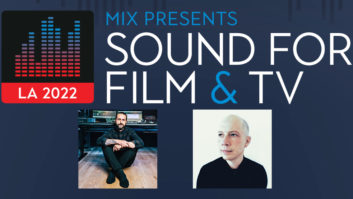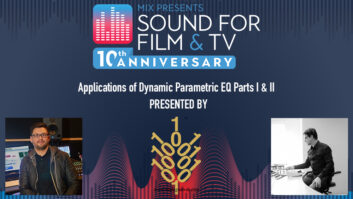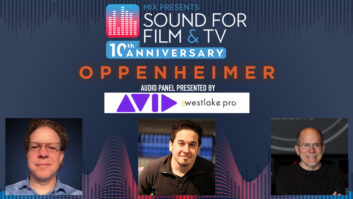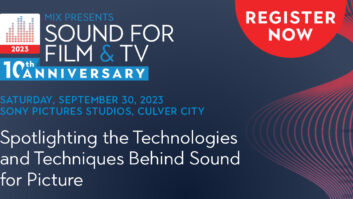Supplementing “Creating The Score, Parts 1 & 2” (May and June, 2011 issues of Pro Sound News), we present additional interviews with film composers Henry Jackman, Geoff Zanelli, Bobby Fernandez, James Hill and Tommy Vicari, each discussing their monitoring practices.
Henry Jackman Q&A with Henry Jackman:
Using a pair of PMC IB2S Reference Monitor Loudspeakers powered by a Bryston 4BSST amplifier.
1. How did you first hear about PMC reference monitors?
While working here at Hans Zimmer’s Remote Control Productions in Santa Monica, CA, I heard [scoring mixer] Jeff Biggers’ PMC MB2S system in Studio B [powered by Classé monaural amplifiers]. They sounded truly amazing!
2. What were your initial impressions?
They sounded totally open, with a big, fat sound compared to the monitors I was using at the time. It was the first time I had heard sound coming out of a large pair of loudspeakers where the orchestral mix worked at all levels – I’m constantly analyzing the internal balance of a score in progress. I need that high dynamic response and detailing.
3. How have your PMC systems worked out for you?
I trust them implicitly – and never thought about them since Day #1. I am no longer worried about not having a level playing field upon which aesthetic judgments can legitimately be made. Because it’s all there, I can spend my time worrying instead about the director’s notes and what is supposed to be happening emotionally in the cue. My PMCs do not lie to me. There is no part of my brain that is going: “Let’s try another reference loudspeaker.”
4. What recent projects has the system been used on?
Scores for Gulliver’s Travels, Puss in Boots, Winnie The Pooh and X-Men: First Class for director Matthew Vaughn.
5. What Top Three characteristics of PMC reference monitors do you specifically value?
A. They make you work harder, which ultimately makes for better sounding music.
B. They sound great at all playback levels, from amazingly quiet to deafeningly loud.
C. They have excellent transient response. They simply put out the information you put into them.
• • • • •
Geoff Zanelli
Q&A with Geoff Zanelli:
Using PMC MB2S LCR Reference Monitor Loudspeakers powered by Bryston Model 7BSST amplifiers.
1. How did you first hear about PMC reference monitors?
I heard scoring engineer Jeff Biggers’ PMC MB2S left/center/right system [powered by Classé monaural amplifiers] here at Hans Zimmer’s [Remote Control Productions in Santa Monica, CA] in 2006 while we were working on Outlander and Disturbia.
2. What were your initial impressions?
I thought that they were putting out too much bottom end! Until, that is, I checked my mixes on other PMC monitors and they sounded just the same. Because my original monitors weren’t reproducing the bottom end, I was over emphasizing the lower frequencies. Now I know exactly what is on the track. Also, the MB2S’ bottom end is deep and tight; my old monitors sounded ‘muddy’ and flat by comparison.
3. How have your PMC systems worked out for you?
Brilliantly! They are totally honest. The playback has clarity during quieter passages, which accurately matches the response of re-recording stages and film theaters – I need to hear that. And I love the spatialization and distinct positioning from my LCR system – width left-to-right and depth front-to-back – that lets me create individual spaces for instruments within a mix.
4. What recent projects has the system been used on?
Clash of the Titans, Outlander, Ghost Town, Disturbia, Hitman and Gamer; I also co-wrote the song “Don’t Make Me Wait” for Disturbia. And I co-wrote with Hans Zimmer and Blake Neely the score for HBO’s mini-series, The Pacific – I created every note on these speakers!
5. What Top Three characteristics of PMC reference monitors do you specifically value?
A. The fact that mixes translate accurately between my composing room to the mix stage to movie theaters.
B. A lack of ear fatigue – I can work long hours in my room and not get exhausted; my hearing remains fresh.
C. They offer outstanding power; the sound is excellent at all playback levels. The MB2S monitors provide a wide, faithful dynamic range with outstanding clarity.
• • • • •
Bobby Fernandez
Q&A with Robert “Bobby” Fernandez:
Using PMC TB2S-A MkII and PMC IB1S Reference Monitor Loudspeakers powered by Bryston Model 6B power amplifiers at Secret Studio personal-use facility, with MB2S LCR Reference Monitors powered by Bryston 4B and 7B amplifiers as a portable rig for scoring dates.
1. How did you first hear about PMC reference monitors?
I guess it must have been at a recording studio or dub stage – I have been using PMCs for so long that it is hard to remember my first experience.
2. What were your initial impressions?
That they sounded faithful and capable of reproducing the wide, highly accurate dynamic range I need for my recording and film-score sessions.
3. How have your PMC systems worked out for you?
All three systems – TB2S-A MkII Active Reference Monitors as near fields, IB1S Reference Monitors as my main monitors and three MB2S Reference Monitors loaded into custom road cases for scoring sessions – are totally consistent and totally accurate. I can work for long hours at lower levels on the TB2S-A MkII near fields and then put the stereo/surround mix up on the IB1S three-way cabinets. The mixes always sound exactly the same.
4. What recent projects has the system been used on?
Clint Eastwood’s three recent offerings: Gran Tornino, Invictus and Hereafter; upcoming scores include Battle: Los Angeles with director Jonathan Liebesman and Priest, plus a record project with artist Jackie Evancho.
5. What Top Three characteristics of PMC reference monitors do you specifically value?
A. That the mid-range and high-end are very well defined.
B. An extended low-end response from my Bryston-powered MB2S Reference Monitors, which I need to determine how my mix will translate to movie cinemas. I don’t like LFE subwoofers – I prefer to have the mains handle the low end so that I know it will be reproduced accurately. For me, the 0.1 is an effects channel that is used to emphasize a screen event, and should not be used to carry the lower octave of a film score.
C. They accurately follow either a flat response or the industry-standard X-Curve – this is essential when we are playing back cues.
• • • • •
James Hill
Q&A with James Hill:
Using PMC IB2S LCR Reference Monitor Loudspeakers powered by a pair of Bryston 4BSST amps and SB100 subwoofer for low-frequency extension.
1. How did you first hear about PMC reference monitors?
I heard [composer] James Newton Howard’s PMC system and was very impressed with how they handled complex musical signals.
2. What were your initial impressions?
They sounded amazing – very detailed and not hyped. They are full range so I don’t need a subwoofer. My IB2S Reference Monitors go down low and are impressive in the lower registers. The mid-range is very slightly prominent, which I like. You need to hear what is happening in the mid frequencies so that you can detect harshness in string sections. They are also great for mixing rock music – they have great presence. I liked them immediately!
3. How have your PMC systems worked out for you?
I’ve been using them for almost three years. They are compact and fit well into my downtown project studio; I can also transport them easily to scoring stages.
4. What recent projects has the system been used on?
Scores for Highland Park, A Good Old Fashioned Orgy, Love, Wedding, Marriage, The Chosen One and Charlie St. Cloud, plus No Ordinary Family and Mad Men TV series.
5. What Top Three characteristics of PMC reference monitors do you specifically value?
A. They are compact, full range and do not require a subwoofer. They reproduce a wide dynamic range, with substantial bottom end that handles Kodo drums and bass-drum rolls.
B. They provide good detailing and imaging, particularly in the mid-range, which is very slightly prominent and lets you hear – for example – harshness in string sections.
C. They are versatile; with their mid-range presence, the IB2S is perfect for rock music.
• • • • •
Tommy Vicari
Q&A with Tommy Vicari:
Previously used PMC MB1S Reference Monitor Loudspeakers; now using MB2S-XBDs for left/right and MB2S-C for center powered by PMC amplifiers.
Working regularly with composer Thomas Newman, who uses PMC IB1S reference loudspeakers in composing room.
1. How did you first hear about PMC reference monitors?
From Thomas Newman, who has been a major fan of PMC monitors for a number of years. On his advice, I bought the MB1S system and then these new left/center/right MB2S-XBD Reference Monitors with the XBD low-end extension for scoring stages and remix studios. With the XBD low-end extension I don’t need subwoofers.
2. What were your initial impressions?
I heard the MB2S-XBD Reference Monitors first at The Village and discovered immediately that they sounded very clean and beautiful – amazing, in fact.
3. How have your PMC systems worked out for you?
MB2S-XBD Reference Monitors are perfect! They offer a full low-end to 135 dB, if we need it. They are also very, very neutral with no hype and no coloration in the top end. I always tell people I like PMC monitors; nobody doesn’t like them!
4. What recent projects has the system been used on?
I’ve used the PMC MB2S-XBD Reference Monitors on Thomas Newman’s score for The Debt, directed by John Madden, and The Adjustment Bureau, written and directed by George Nolfi. Also: The 5th Execution for the Russian composer Yuriy Poteenko, whose cues I mixed over night and then sent trial balances via the Internet.
5. What Top Three characteristics of PMC reference monitors do you specifically value?
A. The clarity of playback is totally faithful and transparent. I can run the system all day at 90 dB with no problems, which lets me hear everything I need in the mix, including odd session noise or ground hums, etc.
B. The system offers full-range playback, and mixes sounds the same at all levels.
C. The low-end response is full and enveloping, but with no fatigue.







